 |
|
|
|
CATCHER'S MASK DATING GUIDE |
| |
The dating
of a catcher's mask could be very difficult as the
basic designs for some masks were used for a long
period of time, and by a number of manufacturers. In
some cases the only way to accurately date a mask is by
matching it to an ad or catalog like a fingerprint. The
manufacturing method
could help for example; electric weld steel wire was
introduced in 1911, and could assure the mask was made
no earlier than 1911 but the loop and clip assembly
that was used prior to the the electric weld was used
for some years later.
The materials used to construct the mask could also be
useful in dating. |
|
|
|
|
Sample |
|
Detailed Information & Pictures |
|
Notes |
|
|
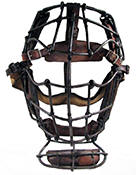 |
|
| |
The first Catcher's
masks were used in
1875, were heavy,
clumsy and impleaded
the sight of the
catcher. The first
retail catchers mask
was made available by
Spalding in 1877. All
leather head straps are
used to secure the mask
to the head, chin and
forehead for support.
Side padding is used to
cushion the face |
|
|
|
 |
|
| |
Just like the Catchers
masks of the 1800's
Looped & Clipped steel
wire is used to build
the frame.
The bright steel & "Gun
Metal" is being coated
with black enamel.
Elastic head bands and
sunshades are
introduced into the
market. Forehead pads
are starting to replace
straps at the very end
of the decade |
|
|
|
 |
|
| |
The first
electric welded steel
wire masks hit the
market, gradually
replacing the Loop &
Clip construction. Full
length padding that
extends around the
sides and across the
forehead are becoming
more common. "The Spitter" hole hits the
market. Wide sight,
open vision frames
start replacing the
"Goggle Eyes" AKA
Spiderman Masks. |
|
|
|
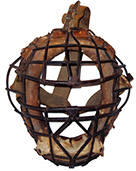 |
|
| |
The one piece
constructed frame with
the padding strapped to
the frame makes an
appearance but does not
catch on fully until
the 1940s. The electric
weld Steel Wire still
dominates the market
and truss construction
is added to the mix.
Open vision masks are
quickly replacing the "Spiderman"
masks. |
|
|
|
 |
|
| |
Heavy Carbon steel wire
is now being used.
Ridged 5/8" round
bars are replacing the
"wire mesh" masks.
Double and triple
wiring with Truss
construction is
becoming more common as
well as, padding laced
to the frames.
Padded chin rests are
replacing the leather
chin pads. |
|
|
|
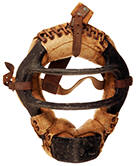 |
|
| |
Double and
triple carbon steel
wire, Truss
construction masks
continue to be
developed, and are
being made with a
broader design. Face
padding is commonly
laced to the frame. The
one piece double bar
masks are becoming more
common than the
previous two decades. |
|
|
|
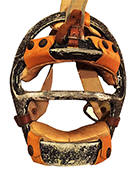 |
|
| |
The one piece two-bar
style catchers masks
dominate the market.
Unlike the pervious
models of the 1930's
and 1940's where lacing
was used, buttons are
used to secure the
padding to the frame.
This style makes it
into the 1960's but
become more
streamlined. |
|
|
|
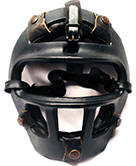 |
| |
1960 - 1969
Catcher's Mask Dating Guide |
|
| |
The one piece double
bar catchers masks are
still holding on and
being made with a more
streamlined design. The
welded carbon steel
wire masks are
becoming the more
popular choice with
catchers. |
|
|
|
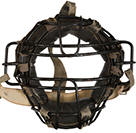 |
| |
1979 - 1979
Catcher's Mask Dating Guide |
|
| |
The The welded carbon
steel wire masks
are being developed to
the max, and dominate
the market. Ear
protectors are almost
standard and attached
throat protectors are
the new fad. |
|
|
|
| Catchers Mask Timeline |
- 1877 Spalding introduces the first
retail Catcher's mask
- 1891 Spalding introduces a
Patented Molded Leather "Sunshade"
- 1907 Reach introduces Elastic Head
Straps
- 1911 D&M introduces Electric
Welded steel wire construction
- 1912 Reach introduces "Wide Sight"
frame construction Spalding
- 1914 Reach introduces "The Spitter"
hole
- 1914 The first use of chin padding
start to replace chin straps.
- 1916 the use of Truss support &
double wire construction.
- 1921 Aluminum one piece frame is
patented by umpire James E. Johnstone.
- 1930 Two, "eye space bars" each
constructed with three wires is patented.
- 1935 One piece molded frame with
two "eye bars" affixed to it is patented
|


